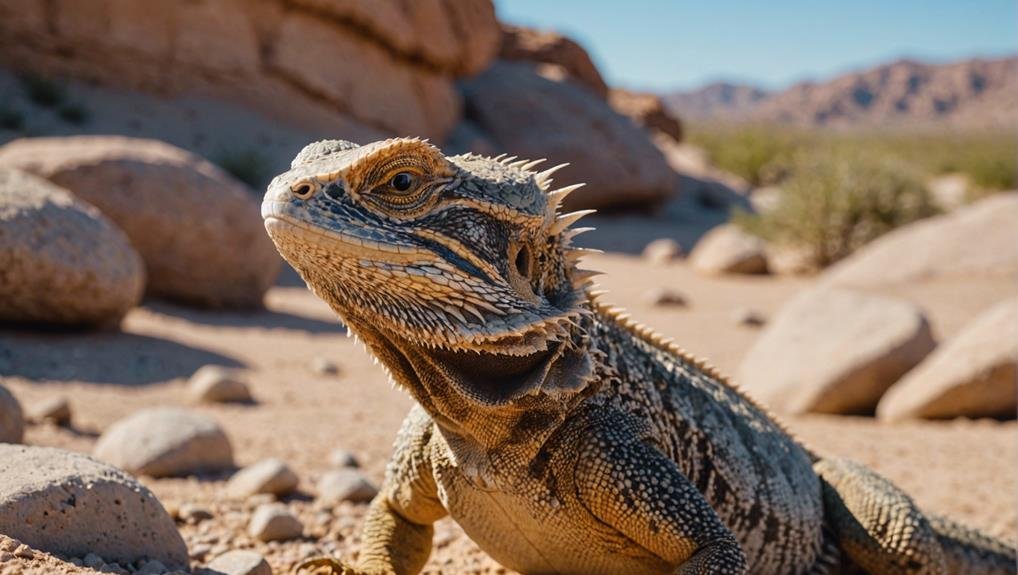When you observe your bearded dragon bobbing its head, it might initially seem important or even amusing. However, this behavior is essential to communication and social interaction among these reptiles. Head bobbing plays multiple roles in their social dynamics, from establishing dominance to signaling submission. You might wonder why these behaviors are significant and what triggers cause them. Understanding the contexts in which these head movements occur can offer valuable insights into your pet’s well-being and social structure. So, what exactly prompts your dragon to bob its head, and what does it mean for their interactions?
Key Takeaways
- Bearded dragons bob their heads to assert dominance and establish social hierarchy.
- Head bobbing is used during courtship displays to signal readiness to mate.
- Territorial behavior often triggers head bobbing to defend their space.
- They bob their heads as a greeting gesture to other dragons.
- Environmental changes and stressors can cause increased head bobbing.
Territorial Behavior


Bearded dragons bob their heads to assert dominance over their territory. This behavior is an important part of their territorial behavior and plays a critical role in their social dynamics.
When you keep multiple bearded dragons in the same enclosure, also known as multi-dragon enclosures, you’ll notice head bobbing as they try to establish who’s in charge. The intensity and speed of these head bobs can vary, indicating different levels of dominance.
This display can sometimes escalate into aggression in multi-dragon enclosures, especially if the dragons feel their territory is being threatened. To prevent fights, it’s essential to monitor their interactions closely. If you see frequent head bobbing and other signs of hostility, it might be best to separate them to establish individual territories.
Understanding this territorial behavior helps create a harmonious environment for your bearded dragons. By recognizing the significance behind their head bobbing, you can better manage their social dynamics and make sure each dragon feels secure in its space.
This way, you’ll maintain a peaceful enclosure where your dragons can thrive without constant territorial disputes.
Social Hierarchy
Head bobbing in bearded dragons serves as a territorial display and plays a significant role in establishing their social hierarchy. When you observe a bearded dragon, you’ll often see males engaging in quick head bobbing. This behavior clearly indicates aggression and an attempt to assert dominance over other dragons. In the wild, this helps establish social rankings within their group, ensuring each dragon knows its place.
On the flip side, if a dragon responds with slow head bobbing, it’s showing submission. This submissive gesture acknowledges the dominant dragon’s higher status in the social hierarchy. By understanding these different head-bobbing behaviors, you can better recognize social interactions among your bearded dragons.
In a captive environment, paying attention to head bobbing is essential. It allows you to identify potential conflicts and manage aggression more effectively. Knowing which dragon is asserting dominance and which is submitting helps you create a more harmonious living arrangement for your pets.
Courtship Displays
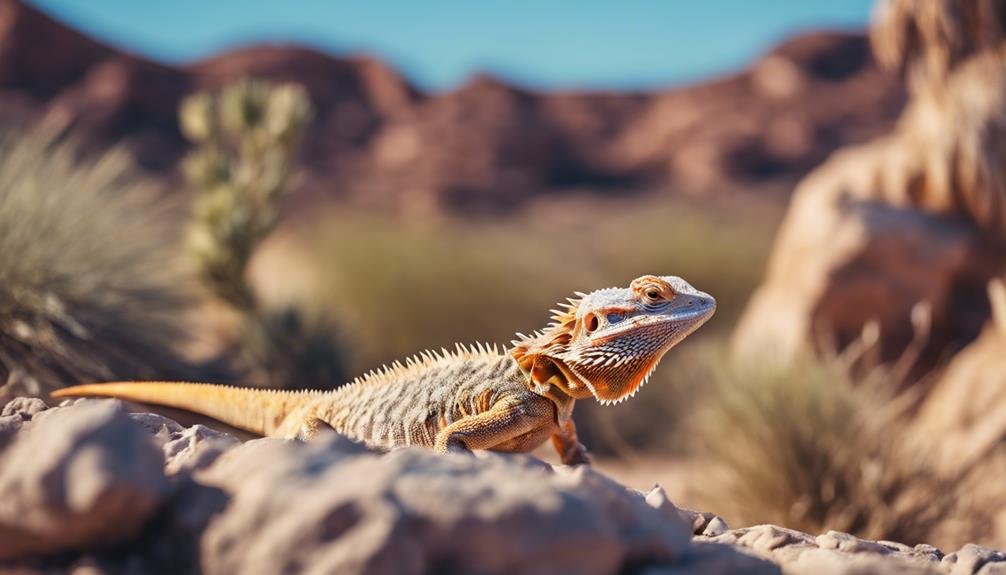

During courtship, male dragons exhibit fast, vigorous head bobbing to assert dominance and show their interest in mating. This jerky head bobbing, often accompanied by the darkening of their beards, indicates that male dragons intend to find a mate and deter other males from their territory. These courtship displays are vital during the mating season, as they help male dragons communicate their intentions and establish dominance.
Female dragons respond differently. Their head bobbing is slower and more deliberate, signaling their readiness to mate and acceptance of the dominant male’s advances. This interplay of head-bobbing behaviors between male and female dragons forms the core of their courtship rituals. The distinct roles each sex plays during these displays reflect their respective strategies in the mating process.
For male dragons, fast head bobbing is a way to showcase strength and fitness, while for female dragons, slow head bobbing indicates receptiveness and choice.
Environmental Triggers
Various environmental triggers can prompt bearded dragons to start bobbing their heads. As a bearded dragon owner, you might notice this behavior when there are changes in habitat, such as rearranging their enclosure or introducing new decor. These changes can make your bearded dragon unsettled or curious, leading to head bobbing.
Environmental triggers also include shifts in lighting and temperature. If the lighting is too bright or the temperature changes significantly, your dragon might respond by bobbing its head. Maintaining a consistent and appropriate habitat setup is vital to comfort your pet.
Stressors in the environment, like loud noises or sudden movements, can cause increased head bobbing. Bearded dragons thrive in stable and calm environments, so minimizing disturbances is important. Loud music, barking dogs, or even frequent handling can stress your dragon, prompting them to bob their heads more often.
Interaction With Humans
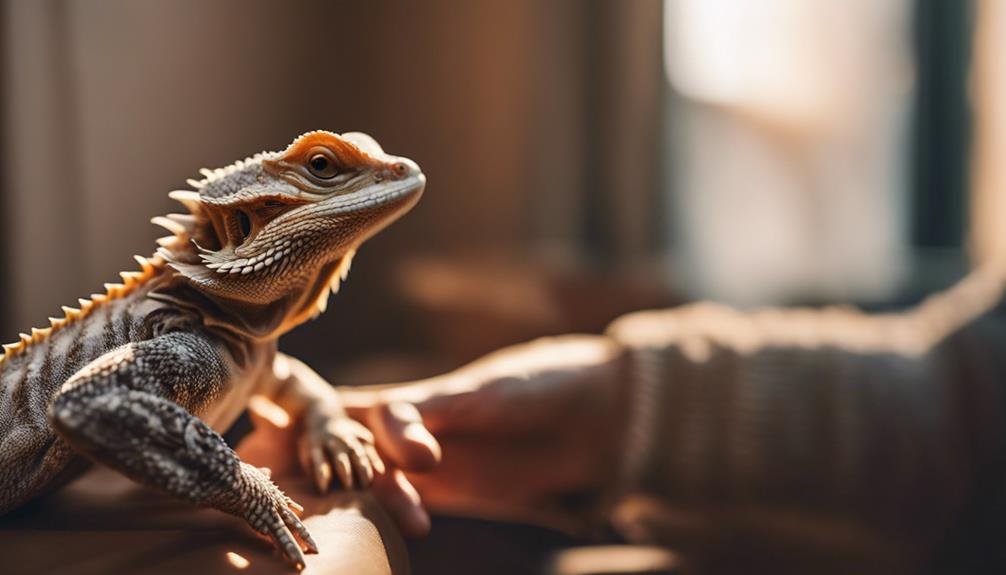

When bearded dragons bob their heads at humans, it often communicates dominance or submission. This behavior can directly react to your presence or a new environment. Understanding the reasons behind bearded dragon head bobbing helps you build a better relationship with your pet.
When a bearded dragon bobs its head at you, it might be trying to show dominance. This is especially common when they’re introduced to a new environment and are unsure of their surroundings. Conversely, they might display submission if they see you as a more dominant figure. In either case, the head bobbing signifies an attempt to establish a social hierarchy.
New bearded dragons will likely exhibit head bobbing more frequently until they build trust with you. It’s their way of gauging your behavior and asserting their own. By understanding these signals, you can respond appropriately and ease their anxiety. Implementing bonding strategies, like gentle handling and consistent interaction, can help reduce this behavior over time.
Understanding the reasons behind bearded dragon head bobbing improves your interaction and fosters a sense of security and trust between you and your pet.
Female Bearded Dragons
Like their interactions with humans, female bearded dragons use head bobbing to communicate important messages, especially related to dominance, submission, and reproductive behaviors. When a female bearded dragon bobs her head, she might establish dominance or show submission to other dragons in her territory. This behavior helps to maintain social order and minimize conflicts within the group.
Female bearded dragons also exhibit head bobbing during mating season. Hormonal changes can drive behavior, making them more active and communicative. You might notice a female scratching at the walls, digging, or showing signs of agitation if she’s gravid (carrying eggs). These actions often accompany head bobbing, signaling her readiness for nesting and egg-laying.
Even solitary females can display territorial behaviors, using head bobbing to assert dominance over their space. This head movement isn’t just limited to social interactions; it can also be a way for her to express discomfort or stress.
Paying attention to the context in which your female bearded dragon bobs her head can provide valuable insights into her needs and well-being. Understanding these signals will help you better care for your pet and respond appropriately to her behaviors.
Juvenile Head Bobbing
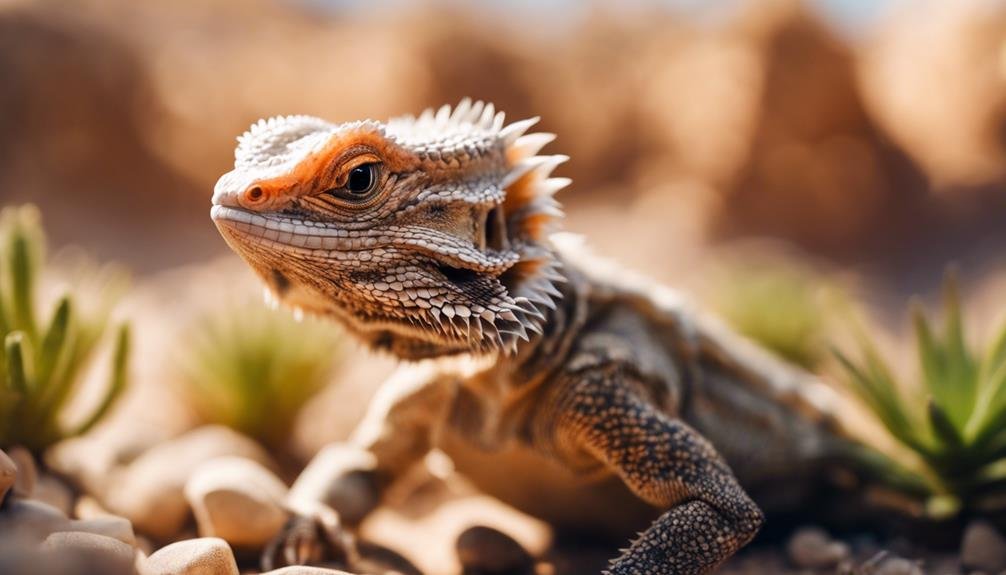

Juvenile bearded dragons often bob their heads in response to new environments or interactions, showcasing a natural instinctual behavior. When you introduce a young dragon to a new habitat or encounter, they might start head bobbing to express their feelings. This head shaking can be essential to their social behavior and communication.
As juveniles, these dragons use head bobbing to establish a social hierarchy within their group. It’s a way to communicate their status and intentions to others. If you notice a juvenile head bobbing around other dragons, they’re likely trying to assert dominance or understand their place within the group.
Head bobbing in juvenile bearded dragons can indicate curiosity, excitement, or stress. If your young dragon is in a new environment, they might bob their head to signal their curiosity or to explore their surroundings.
Conversely, rapid or aggressive head bobbing might suggest they’re feeling stressed or threatened.
Head Bobbing During Sleep
If you notice your bearded dragon bobbing its head while sleeping, it might be due to disturbances in its sleep environment. Bright lights in the enclosure can be disruptive, leading to restless sleep and head bobbing as your dragon tries to get comfortable. To guarantee a good night’s sleep, ensure the enclosure is in total darkness at night.
A dark, quiet environment can greatly improve your dragon’s sleep quality. Consider turning off any nearby lights or covering the enclosure with a breathable cloth to block out excess light. This simple adjustment can often reduce head bobbing during sleep.
It’s also important to monitor the overall environment where your dragon sleeps. Loud noises, sudden movements, or temperature fluctuations can also disturb their rest. A stable, calm environment will help your dragon feel secure and sleep more soundly.
While head bobbing during sleep is usually harmless, it’s crucial to be observant. If other signs of distress accompany your dragon’s head bobbing, it might indicate a more serious issue. However, in most cases, addressing the sleep environment effectively resolves the head shaking.
Frequent Head Bobbing Concerns
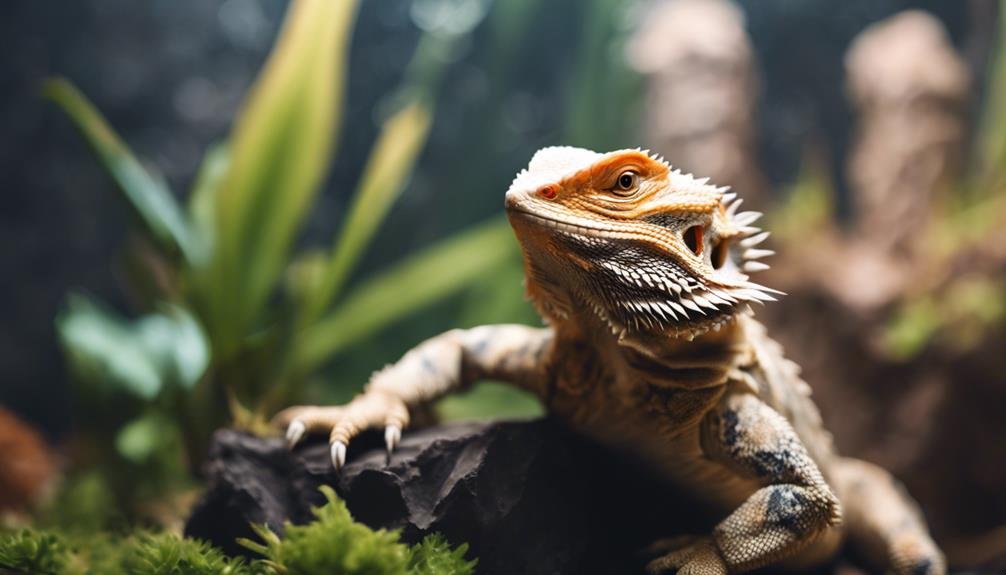

Frequent head bobbing in bearded dragons can signify stress or dominance behaviors. When your bearded dragon bobs its head often, it might react to environmental stressors. These stressors can include changes in habitat, new decorations, or even the presence of other pets. Identifying and eliminating these stressors is important to help your dragon feel more secure.
Additionally, head bobbing is a common display of dominance, especially among male bearded dragons. If you have multiple dragons, you might notice males bobbing their heads at each other to establish hierarchy. This behavior can also be directed at females, particularly during mating season. Males tend to bob their heads more frequently during this time to show interest and assert dominance.
Understanding why your bearded dragon is continuously head bobbing can help you address any underlying issues. If it’s related to stress, make adjustments to their environment. If it’s about dominance or mating season, this behavior is usually normal and not a cause for concern.
Monitoring their behavior helps make sure they remain healthy and stress-free.
Greeting Behavior
Head bobbing in bearded dragons often serves as a friendly greeting towards other dragons or their owners. When bearded dragons bob their heads, they acknowledge the presence of another being, whether it’s a fellow dragon or a favorite human. This greeting behavior is a common social interaction, helping to establish a peaceful connection.
Head bobbing can be an especially prevalent form of communication for young dragons. These young lizards may nod to each other without any sign of aggression, purely as a friendly gesture. Observing this behavior can help you understand that your bearded dragon is comfortable and socializing well.
Imagine the following scenarios:
- Two young dragons in a terrarium are nodding to each other non-threateningly.
- A bearded dragon greets its owner with a series of calm head bobs.
- A lizard acknowledges a new object or change in its environment with a subtle nod.
- Young dragons’ heads bob as they explore their surroundings together.
Bearded dragons bob their heads for various reasons, but as a greeting behavior, it’s a sign of their social nature. By understanding this, you can better appreciate your pet’s interactions and promote a harmonious environment.
Conclusion
Understanding why bearded dragons bob their heads helps you better interpret their behavior and care for them. These head movements are key to their social interactions, whether they’re establishing dominance, courting, or greeting you.
By recognizing these signals, you can manage their environment more effectively and guarantee their well-being. So, keep an eye on your dragon’s head bobbing; it’s their way of communicating and maintaining harmony in their world.

